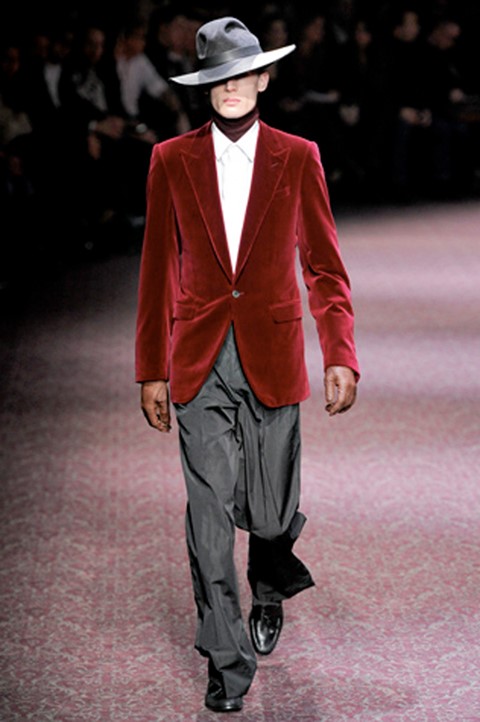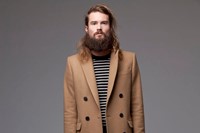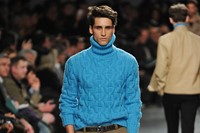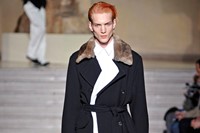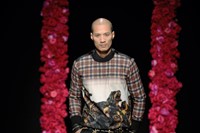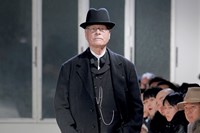When Alexandre Mattiussi premiered the first collection of his Ami label in an intimate bar setting rather than streaming live via optic fibre cables, he hit a tone that is reflected in many collections this menswear season in Paris. "I created the
When Alexandre Mattiussi premiered the first collectiona of his Ami label in an intimate bar setting rather than streaming live via optic fibre cables, he hit a tone that is reflected in many collections this menswear season in Paris. "I created the wardrobe I always wanted to have", the designer said "but I was also looking for something real." Clad in classic outfits, a square cut camel coat, a double-breasted suit in salt and pepper wool, or a bit more casual in a dark denim jacket over a burgundy cable knit jumper, the models mixed with the crowd in an intimate presentation that almost lost its staged character and turned into a pleasant cocktail party. The warm reds of the interiors at the Au Macéo restaurant in the first arrondissement helped to create a personal note, but they did not overshadow the down to earth vision of the designer, which came as an absolute antidote to Facebook and Twitter.
Maybe this is a very Parisian thing, a tradition that cannot be uprooted so easily by newly created technology. Personal contact, the experience of reality, a feeling for the materials, nothing new, but valuable assets that many designers are not prepared to give up yet and to give in to the digitalization of fashion. "We will never skip the feeling", said Veronique Nichanian at Hermès; "that does not mean we are reactionary, but sometimes we have to slow down a little bit and take our time to discover things." With this reluctant take on modernity, she streamlined the silhouette at Hermès, made jackets a little bit shorter and closer to the body, translated the omnipresent cable knit into a voluminous chain d’ancre motif and rediscovered vintage motorcycle one piece suits that came in bronze shearling and black deerskin.
If there is a hint of nostalgia hidden somewhere under the label of being timeless, Yohji Yamamoto made sure that no one could accuse him of showing boring clothes. He cleverly subverted the polished manière francaise with a collection inspired by the portraits of farmers that the German photographer August Sander took in the late 1920s. Dressed up for church on Sunday, they wore ill fitted three-piece suits with a crumpled hat; on the field they preferred voluminous trousers high on the waist. All these shapes were there, in a collection partly shown on bigger, non-professional models enhancing the round silhouette, but they came with the subtle understanding of fashion that enlivened the rough tweeds and heavy cottons with a splash of bright orange or red lips on a woollen jumper just at the right time to deliver a playful show.
A similar attraction of real people shone through Umit Benan’s presentation during Milan’s menswear week. He offered a very personal take on the investment banker’s wardrobe that was far off corporate blandness and restraint. Classic camel blazers were made fun when paired with boxer shorts and interesting when stuffed under a charcoal sweater rolled up to the waist. It is unfortunate that every banker would have a hard time showing up like this, sporting a full beard, his ear lobe widely pierced to a board meeting.
Not necessarily country life, but nature as quintessential source of inspiration was at the core of Adam Kimmel’s collection based on the Pacific North West. He collaborated with the artist Dan Attoe, who lives in Portland, Oregon on customised drawings, showing motifs like an ape-man in the woods. There were hints of lumberjack, working clothes, but paired with the sophistication of Italian tailoring and pieces conceding to the trends of the season, like an orange winter trench with a black flannel lining.
Even at the big French houses you could feel an atmosphere of sombre restraint, which was less a politically correct answer to a still looming recession than the honest focus on the essentials of the male wardrobe. At Dior Homme Kris van Assche took some inspiration from the Amish and sent his models down the catwalk with wide brimmed black hats, clad in slim tunics, capes, and coats. Two final looks in scarlet red lightened the morbid tone and reinforced a straight silhouette with precisely cut jackets and fluid trousers in super light wool. At Lanvin, the big hats re-appeared as Fedoras worn at a slight angle, which made the show a bit more playful, upbeat and fun. The focus was centred around the suit, for the evening looks in lush silks and velvets even, but you could still sense a distant call from the wild with the occasional appearance of hiking boots among the smooth loafers and a foxtail dangling under an elegant black coat.
Restraint is probably the wrong word to characterise all the furs that hit the runways this season. Dries van Noten’s graphic show was greatly enhanced through the application of soft rabbit on collars, detachable lapels and inserted linings. Balmain gave the military look a noble touch with big shearling coats and luxurious foxes adorning the hoods. Riccardo Tisci at Givenchy spectacularly reworked a brown beaver into a bomber jacket and went so far as putting sheared mink-rimmed glasses on show. This might sound excessive, but it demonstrates the unambiguous power of the real, the lasting impact that is created by effectively touching a furry piece, which just can’t be replaced by a screen, even a touch sensitive one.
Text by George Ghon
